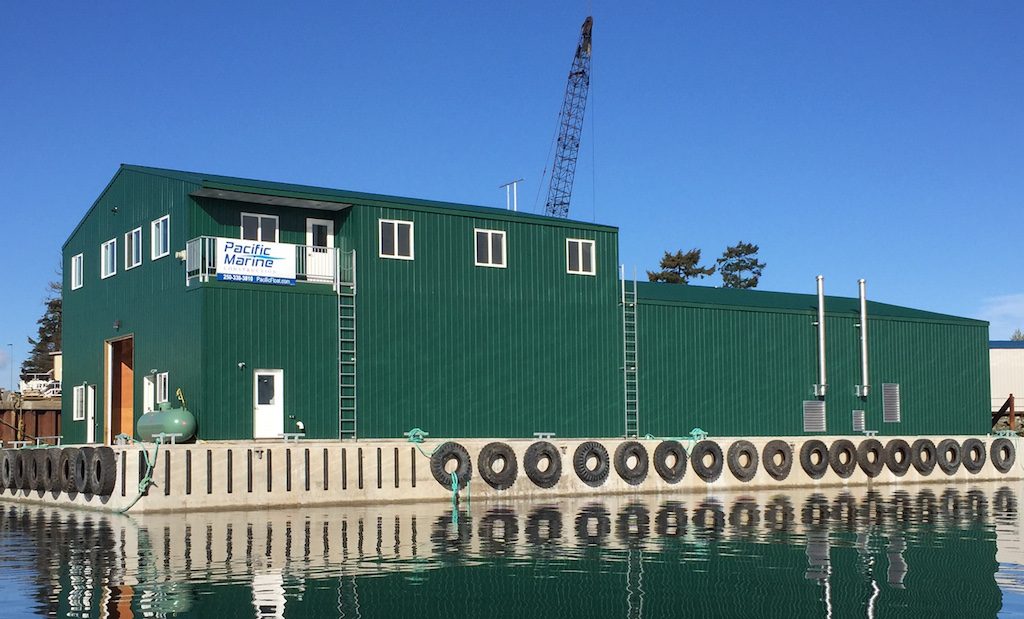
Salmon farmer triples feeding capacity with new barge
April 26, 2016
By Tom Walker
 The Marine Harvest barge Marine Harvest’s $2M structure also addresses lost feeding time due to bad weather
The Marine Harvest barge Marine Harvest’s $2M structure also addresses lost feeding time due to bad weatherSalmon farmers are always looking for ways to improve feed efficiency. Dave Pedersen, the Marine Projects Manager at Marine Harvest (MH) Canada, says that conditions on Canada’s west coast can make feeding a challenge.
“We have the most adverse environmental conditions,” says Pedersen from his office in Campbell River on Vancouver Island. “We are always tackled by low DO (dissolved oxygen), or plankton, or weather, or a short day in the winter. What that means is our time span to feed is usually quite narrow. So what we end up doing is we feed when we are able to feed.”
When you have 24 cages, each growing some 40,000 fish like the MH site at Shelter Pass northeast of Port Hardy, feeding can take a long time with a standard two-blower two-line system. “Typically you could go through and feed two cages at once and that may take a couple of hours for each cage,” Pedersen says.
But conditions might not allow feeding for a couple of hours for each cage. Pedersen says that MH has sites that they cannot even access by boat, over a certain number of days each year. “There is a serious number of days that are lost feeding time,” he says.
So how do you expand capacity when feed storage, pumping systems, staff quarters and maintenance equipment all share float space at a marine site? You build a bigger barge.
At 131 ft-by-53 ft, Pedersen says it’s the biggest, deepest and most robust concrete structure they have. The first floor has 7,000 sq ft of space for feed storage, feed systems, and a dive room. Upstairs there is 2,600 sq ft of living accommodations for both staff and visiting maintenance personnel.
“It will be close to $2 million by the time it’s done,” says Pedersen. “We don’t typically spend this much capital on a project.” But it is obvious that Pedersen is looking forward to the space.
He says that instead of the usual two feed silos, there will be six, each holding five tons of feed. Each silo has its own line and blower system and that triples the feeding capacity at the site. “We can literally feed six cages at one time,” says Pedersen. “It just gives us so much more variance.”
“Feed storage together with a feeding system has always been the concept, but now we have increased the amount of cages we can feed at one time,” he emphasizes. The barge holds a total of 350 tons of feed and will be restocked about every two weeks.
Locally built
Pacific Marine Construction in Campbell River is doing the build. Owner Cory Handyside says styrofoam fills a reinforced concrete shell for the float. That float also holds a 1500 gal water tank for the on board desalinator, a 3500 gal diesel fuel tank and a 600 gallon septic tank. There are 2 diesel generators for electricity, a diesel furnace for heat and propane for cooking.
Handyside says it’s built to “Norwegian standards” but the design is unique to the west coast. When fully loaded at 380 tons, there will be 46 ft of free board.
“I’ve worked with Corey in the past when I used to build barges for other companies,” says Pedersen. “He’s got the expertise.” By going with an island contractor, MH continues their tradition of using as much local help as possible.
A single tug will tow the barge around 190 km to the Shelter Pass site. An engineered system of 10 lines, a high hold anchor and shots of bottom chain will keep it in place.
Pedersen is looking forward to the increased feeding opportunity that the expanded system on the barge will support. “We can now get the feed into the fish when there is a break in the adverse environmental conditions that are always stopping us from feeding.”
— Tom Walker





